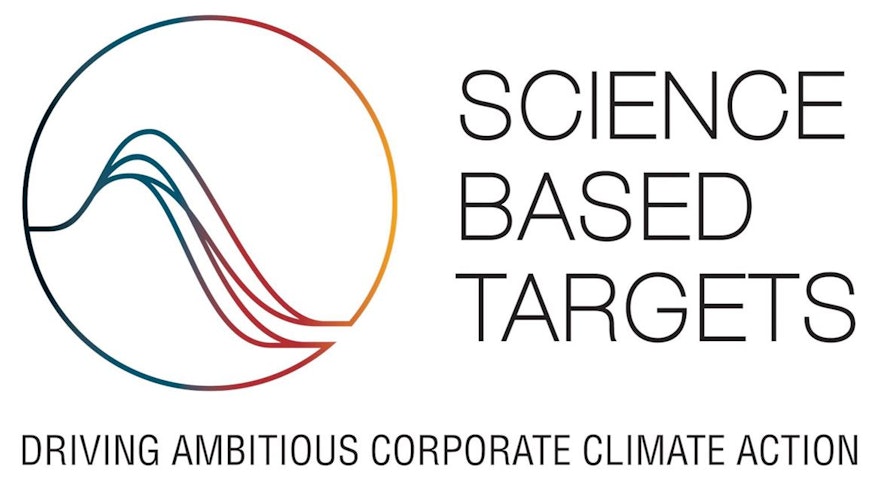SBTi: An Overview
The SBTi, or Science Based Targets initiative, is a collaboration among multiple organizations, including the World Resources Institute, United Nations Global Compact, the World Wide Fund for Nature (WWF), and CDP, formerly known as the Carbon Disclosure Project. Its goal is to help companies establish and accomplish challenging climate targets that comply with the Paris Agreement's objective of limiting global warming to less than 2 degrees Celsius above pre-industrial levels.
To create science-based targets (SBTs), SBTi offers a structure and approach for corporations to follow that set greenhouse gas (GHG) reduction goals aligned with the most up-to-date climate science. These goals aim to be both audacious and transparent, and they can assist businesses in lowering their environmental impact, enhancing their reputation, and increasing their competitiveness in a low-carbon economy.
What do they do?
SBTi defines and promotes best practices in emissions reductions and net-zero targets in line with climate science. It also provides technical assistance and expert resources to companies that set science-based targets in line with the latest climate science.
Its methodology involves setting emissions reduction targets for Scope 1, 2, and 3 emissions, and assessing the feasibility of achieving these targets based on the company's sector and other factors. It offers a range of resources and support to help companies develop and achieve their SBTs, including technical guidance, tools, and access to a network of experts. To participate in the SBTi, companies must commit to setting SBTs within two years of joining and publicly reporting their progress towards these targets on an annual basis.
The SBTi also works with policymakers, investors, and other stakeholders to promote the adoption of science-based targets and to create a supportive policy and market environment for companies to transition to a low-carbon economy. The initiative is a key player in the global effort to address climate change and accelerate the transition to a sustainable future.
The change has already begun and action is gaining pace. Over 2,000 organizations worldwide are leading the transition to a net-zero economy by setting emissions reduction targets grounded in climate science through the SBTi.
What is their purpose?
The purpose of the Science Based Targets initiative (SBTi) is to help companies set and achieve ambitious climate targets that are aligned with the goals of the Paris Agreement. The Paris Agreement is an international treaty that aims to limit global warming to well below 2 degrees Celsius above pre-industrial levels and to pursue efforts to limit warming to 1.5 degrees Celsius.
The SBTi aims to achieve several objectives:

- Drive corporate action on climate change: By providing a clear and credible methodology for companies to set SBTs, the SBTi aims to encourage more companies to take ambitious action on climate change.
- Align corporate action with the goals of the Paris Agreement: The SBTi aims to ensure that corporate climate action is in line with the goals of the Paris Agreement and is consistent with the latest climate science.
- Accelerate the transition to a low-carbon economy: The SBTi aims to help companies transition to a low-carbon economy by setting ambitious emissions reduction targets and developing strategies to achieve these targets.
- Enhance corporate sustainability and competitiveness: By setting and achieving SBTs, companies can enhance their sustainability credentials, reduce their exposure to climate-related risks, and improve their competitiveness in a low-carbon economy.
Now let's deep dive into SBTi's guidelines for Carbon Offsets.
SBTi: Transforming the Way We Approach Carbon Offsets
SBTi has created guidelines for Carbon Offsets as it is considered controversial which stems from concerns about its effectiveness, accountability, and potential to be used as a loophole to avoid real emissions reductions.
Reasons why it is controversial.
- Additionality: The concept of additionality means that carbon offsets should represent emissions reductions that would not have happened without the offset project. However, it can be difficult to determine whether an offset project is truly additional, as there is often no way to verify whether the project would have happened anyway. This has led to concerns that some offset projects are claiming credit for emissions reductions that would have occurred regardless of the offset.
- Permanence: Carbon offsets are based on the assumption that carbon emissions can be removed from the atmosphere in a way that is permanent. However, this assumption is controversial because it is difficult to guarantee that the carbon removed from the atmosphere will stay removed. For example, a forest that is protected for carbon sequestration purposes may be vulnerable to wildfires or deforestation in the future, which could release the stored carbon back into the atmosphere.
- Accountability: The lack of transparency and accountability in the carbon offset market has also led to controversy. It can be difficult to track where the money from carbon offset purchases is going and whether it is actually contributing to emissions reductions. There is also the issue of double-counting, where both the purchaser and the seller of a carbon offset claim the same emissions reduction.
- Effectiveness: Some critics argue that carbon offsets do not effectively reduce emissions because they allow polluters to continue emitting greenhouse gases. Instead of reducing emissions at the source, polluters can buy offsets and claim to be carbon-neutral without actually reducing their emissions.
However, proponents argue that properly designed and implemented carbon offset projects can be a useful tool for addressing climate change.
Hence, SBTi came up with the following criteria to tackle the above-mentioned issues:
Science-based net-zero targets require long-term deep decarbonization targets of 90-95% across all scopes before 2050. When a company reaches its net-zero target, only a very limited amount of residual emissions can be neutralized with high-quality carbon removals, this will be no more than 5-10%.
As a part of the Standard, companies are encouraged to make additional investments in mitigation activities above and beyond their value chain to increase the likelihood the world stays within a 1.5°C carbon budget. However, these investments are not a substitute for a company’s own emission reductions and cannot count towards the 90%+ reduction.
SBTi as a Catalyst for Global Corporate Climate Action
In 2021, there was a significant increase in the number of companies committing to science-based targets through the SBTi initiative. The number of companies doubled to 2,253, with 1,082 companies having approved targets and 1,171 committing to set science-based targets. These companies come from 70 countries and 15 industries, with an average growth rate of 110 new companies per month in 2021, which is a considerable increase from 31 in 2020. Even financial institutions are joining the movement, with 117 committing to set science-based targets since 2015.
As of January to March 2022, almost 500 companies have set or committed to set science-based targets. The SBTi initiative has now entered a phase of exponential growth, with SBTi companies accounting for more than one-third of the global market capitalization, valued at $38 trillion USD, which is a significant increase from 20% in 2020.
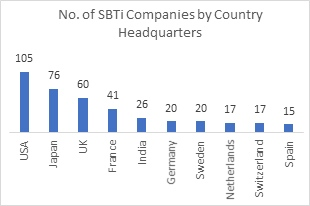
SBTi Companies Around the World: Country-wise Distribution as of April 2019
According to the data presented in the graph, the Science Based Targets initiative (SBTi) has garnered commitments from companies in various countries. As of April 2019, the United States has emerged as the frontrunner with the highest number of commitments. Following the US, the countries with the next highest number of commitments are Japan, UK, France, and India, respectively, making up the top 5 countries in the graph.
Corporate India's Climate Leadership: A Roadmap with SBTi
Overview
As of April 2022, India has emerged as a leader among emerging economies with 79 Indian companies committed to cutting their emissions in line with science through the SBTi initiative. The SBTi has a presence in India and is working with companies to help them set and achieve science-based targets. Companies like Infosys, Mahindra & Mahindra, and Tata Motors have already committed to setting science-based targets. The SBTi has partnered with the Confederation of Indian Industry (CII) to launch the "India Cooling Action Plan," which provides recommendations for reducing greenhouse gas emissions from the cooling sector, as well as a roadmap for developing and implementing science-based targets for companies in the sector.
The SBTi has also launched the "Indian Renewable Energy Buyers Alliance" (REBA), which aims to help companies achieve their science-based targets by transitioning to renewable energy sources.
CDP India’s Science Based Targets Incubator, with funding from the MacArthur Foundation, has been supporting the uptake of science-based targets in India since 2020, providing technical support, information, and campaigns to encourage companies to set science-based targets, with a focus on high-emitting sectors.
Two Indian cement companies, ACC Limited and UltraTech Cement Limited, have approved near-term targets. Moreover, Indian multinational information technology services and consulting company Wipro was among the first companies worldwide to achieve a validated net-zero target. Automobiles and components are the most represented sector, followed by mining and metal, and real estate in India, among the companies committed to setting SBTs.
While speaking at COP26 in Glasgow, Indian Prime Minister Narendra Modi announced the intention for India to achieve net-zero emissions by 2070. Participants agreed that this timeline, despite being 20 years after the 2050 goal set out by the IPCC, still requires transformation of the economy. This includes the power sector becoming completely renewable by 2050, the transportation sector moving towards electricity away from fossil fuels, implementing a carbon trading system, and investing massively in new green technology.
Achieving Net Zero
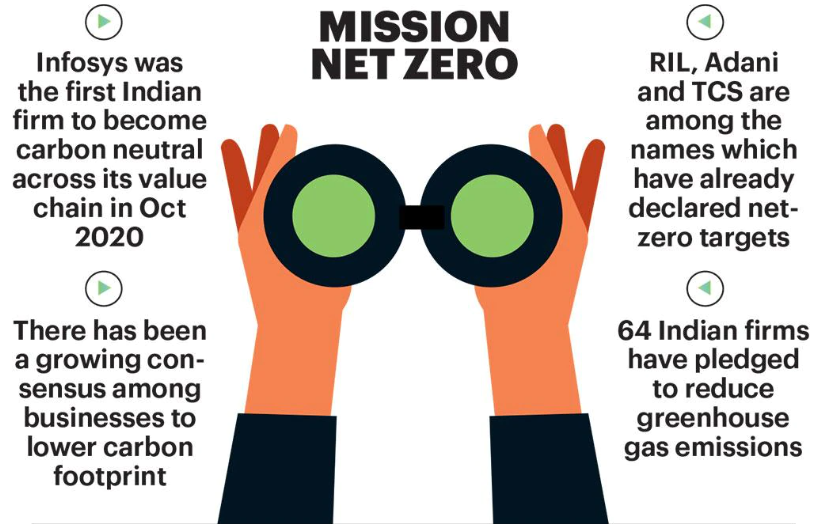
Corporate India's Journey to Net Zero: Milestones and Achievements
To declare themselves net zero under the Science Based Targets initiative (SBTi), a company must first set and achieve science-based targets (SBTs) for greenhouse gas (GHG) emissions reduction that are consistent with limiting global warming to well below 2 degrees Celsius above pre-industrial levels and pursuing efforts to limit warming to 1.5 degrees Celsius, as outlined in the Paris Agreement.
Once a company has achieved its SBTs, it can then set a net-zero target, which involves balancing its remaining GHG emissions with an equivalent amount of GHG removal or offsetting activities. In other words, a net-zero target means that a company aims to have no net emissions of GHGs.
To declare themselves net zero under the SBTi, a company must publicly commit to the following criteria:
- The company has set a 1.5°C-aligned science-based target or has committed to setting one within 24 months of the declaration.
- The company has publicly disclosed its current Scope 1, 2, and 3 GHG emissions inventory.
- The company has publicly disclosed its planned Scope 1, 2, and 3 GHG emissions reductions and is reporting progress against these targets annually.
- The company has set a net-zero target that covers all of its Scope 1, 2, and 3 GHG emissions and has committed to achieving this target within a specific timeframe.
- The company has publicly disclosed its plan to achieve its net-zero target, including how it will address residual emissions and the role of offsets if any.
- The company has committed to conducting regular reviews of its net-zero target and strategy, and to updating these as necessary to reflect the latest climate science.
Overall, to declare themselves net zero under the SBTi, a company must demonstrate a clear commitment to ambitious and credible emissions reduction targets, a robust strategy for achieving these targets, and transparency and accountability in reporting progress towards these targets.
Let’s deep dive into the steps of achieving net zero through a case study of Infosys, the fastest-growing IT services brand in the world.
SBTi as a Key Enabler: A Case Study on Infosys' Journey to Carbon Neutrality
In 2022, the Science Based Targets initiative (SBTi) granted approval to Infosys for its carbon reduction targets. These targets are in accordance with the Paris Agreement's objectives and aligned with the reductions required to maintain a well below 2°C warming trajectory. Infosys has formulated targets that address greenhouse gas (GHG) emissions from all three scopes. SBTi's approval is a testament to Infosys' unwavering commitment to sustaining its carbon neutrality goal beyond the fiscal year 2020.
Infosys has been at the forefront of climate action for the past decade, having reduced its per capita energy footprint by over 50% from 2008 levels, and by adopting cleaner and renewable sources of energy. The company's community-based carbon offsets have had a positive impact beyond its boundaries, benefiting more than 102,000 families. Infosys had set an ambitious carbon-neutral target a decade ago, which it achieved through policy changes and innovation, becoming carbon neutral in fiscal 2020, thirty years ahead of the timelines set by the Paris Agreement.
For three years in a row since FY20, Infosys has been a carbon-neutral company in line with the PAS 2060 standard. The company has set its sights on achieving Net Zero by 2040, which is a decade ahead of the Paris Agreement's timelines.
How did Infosys become carbon neutral?
Setting ambitious emissions reduction targets
In order to progress towards achieving Net Zero, they have adopted the following carbon reduction targets.
Their ESG 2030 vision highlights the following emission reduction targets,
- Maintain Carbon Neutrality across Scope 1, 2, and 3 (all relevant categories excluding Capital goods emissions)
- Reducing absolute Scope 1 and 2 GHG emissions by 75% against Business-As-Usual(BAU).
- Reducing absolute Scope 3 emissions by 30% against the 2020 baseline year.
In addition to the above target, their SBTi target for the mid-term (2025) and long-term (2035) are listed below,
- Absolute mid-terms Scope 1+2 and 3 emission reduction of 12.5% by 2025 against the 2020 baseline.
- Absolute long-term Scope 1+2 and 3 emission reduction of 37.5% by 2035 against the 2020 baseline.
They project that carbon emissions will decrease over the next five years to 447,000 tCO2e by 2025. This is a reduction of 12.5% from the baseline year 2020.
Strategizing every move:
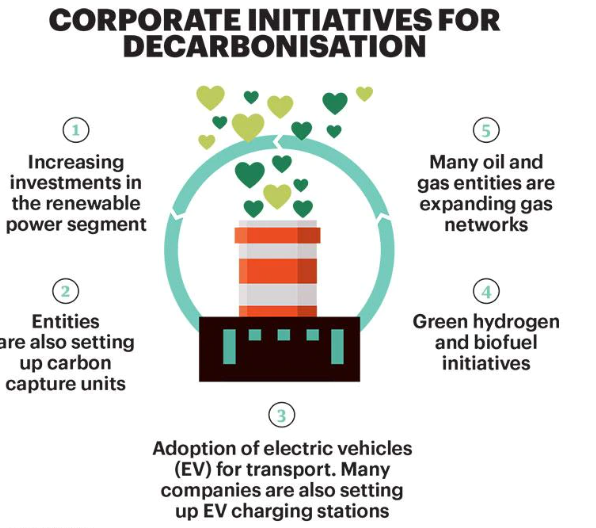
Decarbonizing the Corporate World: Innovative Initiatives and Strategies
Infosys’s strategy for carbon neutrality has been in function since 2008, providing them with time to reduce their Scope 1, 2, and 3 emissions and offset the remaining emissions.
Scope 1 :
- Better operational efficiency of our DG sets
- Better management of fugitive emissions from HVAC units
- Transition to EVs for company-owned vehicles
Scope 2 :
- Design and build or lease new offices with low Energy Performance Index (EPI)
- Retrofit old buildings to improve EPI
- Source renewable power
Scope 3 :
- Include a hybrid working model
- Promote EVs among employees
- Transition to EV for our owned vehicles and hired cabs
- Promote carpooling, public transport, and low to zero-emission modes of commuting among employees
- Optimise business travel
- Focus on leased offices that are efficient
- Adopt a life cycle approach for capital goods
Plan in Action: 2020 Achievements
Infosys built a strategy around energy efficiency, renewable energy (RE), and carbon offsets. Then, it evolved a pathway for Scope 1 (direct emissions from controlled sources), Scope 2 (indirect emissions from purchased electricity sources), and Scope 3 (other indirect emissions), to achieve carbon neutrality. “Over a decade of focused effort has gone into becoming carbon neutral. We started the journey in 2008. In 2011, we made a voluntary commitment to become carbon neutral by 2020,” says Bose Varghese, Head of Green Initiatives at Infosys.
Over this period, the company invested heavily in energy efficiency, RE, and community-based carbon offset projects, he adds. In 2020, when Infosys turned carbon neutral, its RE component was 44 percent, while emissions from the remaining 56 percent of electricity had to be offset to achieve carbon neutrality. RE usage has grown to 53.8 percent in FY22.
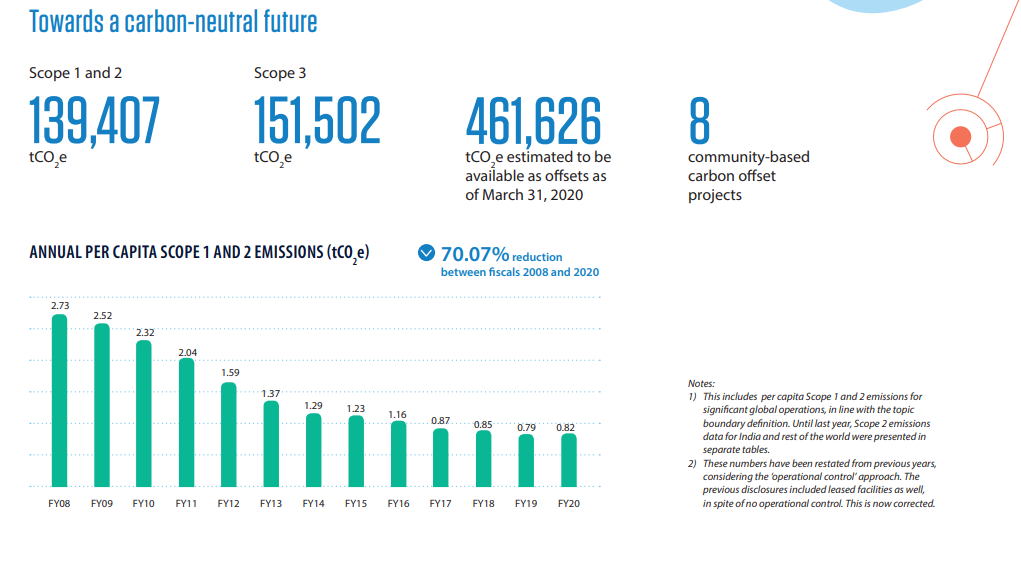
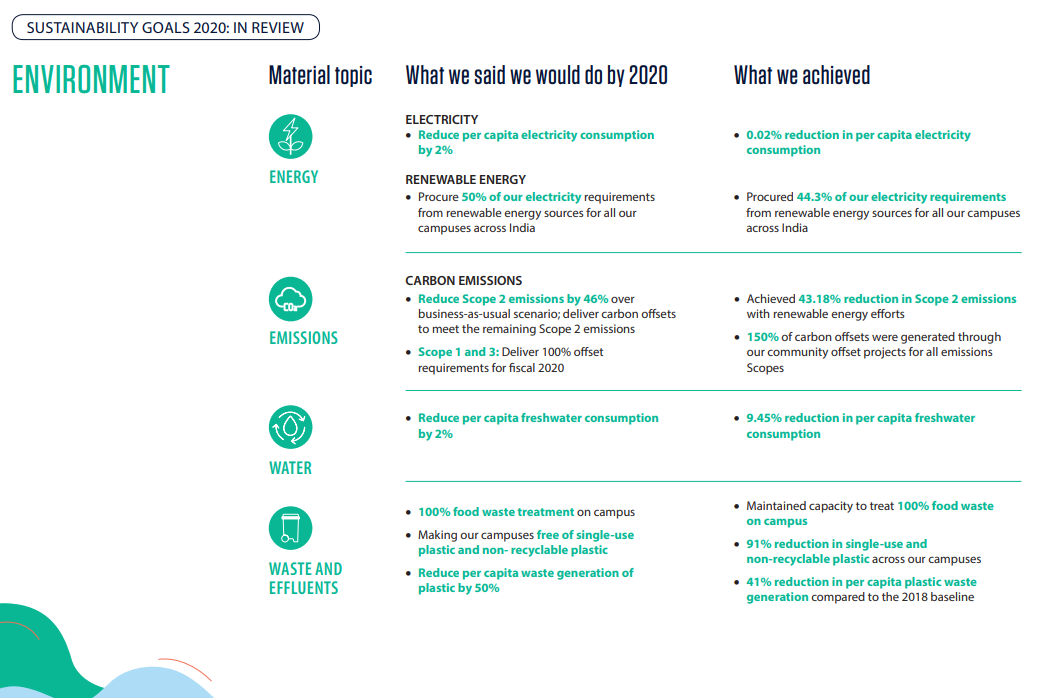
Sustainability Success: Infosys Achievements in 2020
Infosys Framework for sequencing decarbonization efforts
A framework for sequencing decarbonization efforts is important because it can help organizations prioritize their emissions reduction efforts and allocate resources more effectively to achieve their climate targets. The framework below illustrates how Infosys balanced savings and continuously reduce operational and embodied carbon.
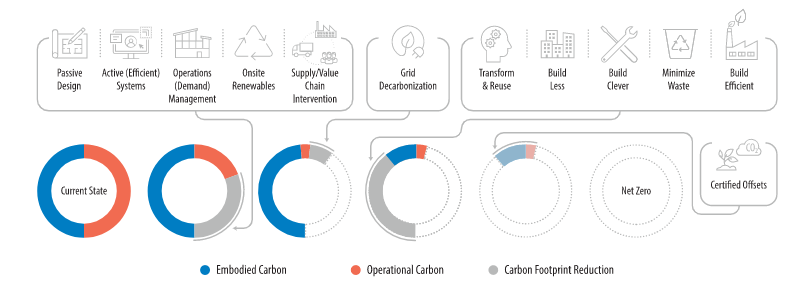
Infosys' Guide to Decarbonization: A Sequential Framework for Sustainable Transformation
By implementing initial measures such as the adoption of renewable energy and enhancing the efficiency of systems, organizations can achieve immediate results. This provides them with additional time to gain insights and reevaluate their strategies for optimizing space usage and minimizing the need for constructing new buildings. Certified carbon offsets must be considered as the ultimate step to bridge any gap that may remain after all other decarbonization efforts have been fully maximized.
Carbon Offsetting: A Key Step in Infosys' Journey to Carbon Neutrality:
Infosys' community-based carbon offset program serves the dual purpose of promoting climate action and creating a positive impact on rural communities. The program focuses on projects that aim to reduce future greenhouse gas (GHG) emissions while supporting rural development. To achieve this objective, Infosys has implemented five efficient cookstove projects, two biogas projects, and one rural electrification project.
The carbon offset projects implemented by Infosys are having a positive impact on several families in rural India, with the goal of eliminating poverty, reducing inequalities, and protecting the planet. Third-party verification has confirmed that their existing projects have generated 347,470 tCO2e offsets. These carbon credits will be used to fulfill Infosys' carbon-neutral commitment.
Infosys’s biogas and cookstove projects in India generated over 2,400 jobs while benefitting more than 102,000 families.
Infosys Active Carbon Offset Projects

Different types of carbon offset projects used by Infosys to create a positive socio-economic impact

Synopsis:
Previously, only companies with a strong sustainability focus had a focus on decarbonization. Nowadays, sustainability priorities have become mainstream and are expected by customers, investors, and regulators. Therefore, it is imperative for companies to recognize that sustainability is no longer a niche concern but essential for the health of the planet and their enterprise.
To achieve this, the first step is to establish science-based targets (SBTs). By setting SBTs, companies can take tangible measures to decrease their greenhouse gas emissions and contribute to the worldwide effort to tackle climate change.
The importance of the SBTi lies in its ability to mobilize the private sector to take action on climate change. As businesses are responsible for a significant portion of global greenhouse gas emissions, their actions can have a significant impact on the global effort to address climate change. By setting and achieving SBTs, companies can demonstrate their commitment to addressing climate change and help to accelerate the transition to a low-carbon economy.

![[object Object]](/lib_ubcXiSgTRmkLVyyT/k8w528b9mk1p20to.png?w=400)
